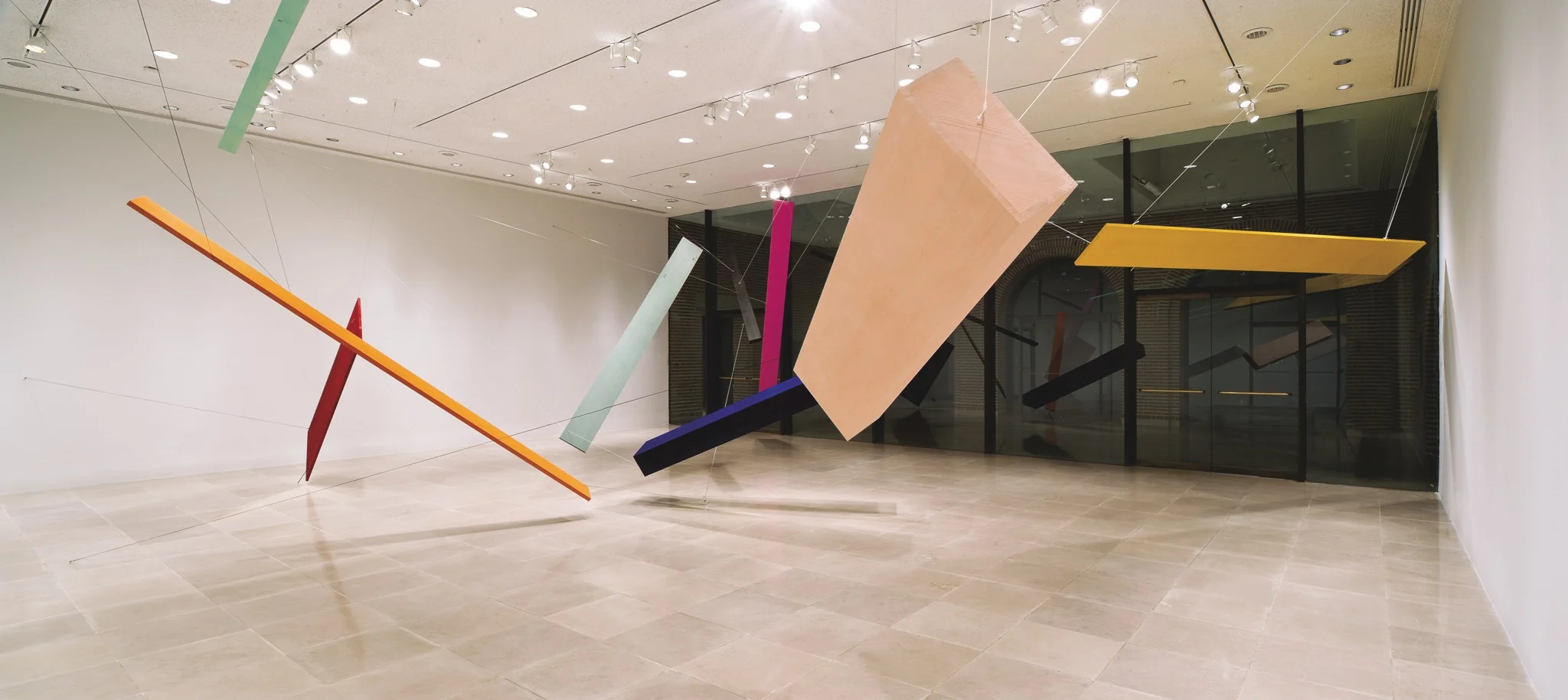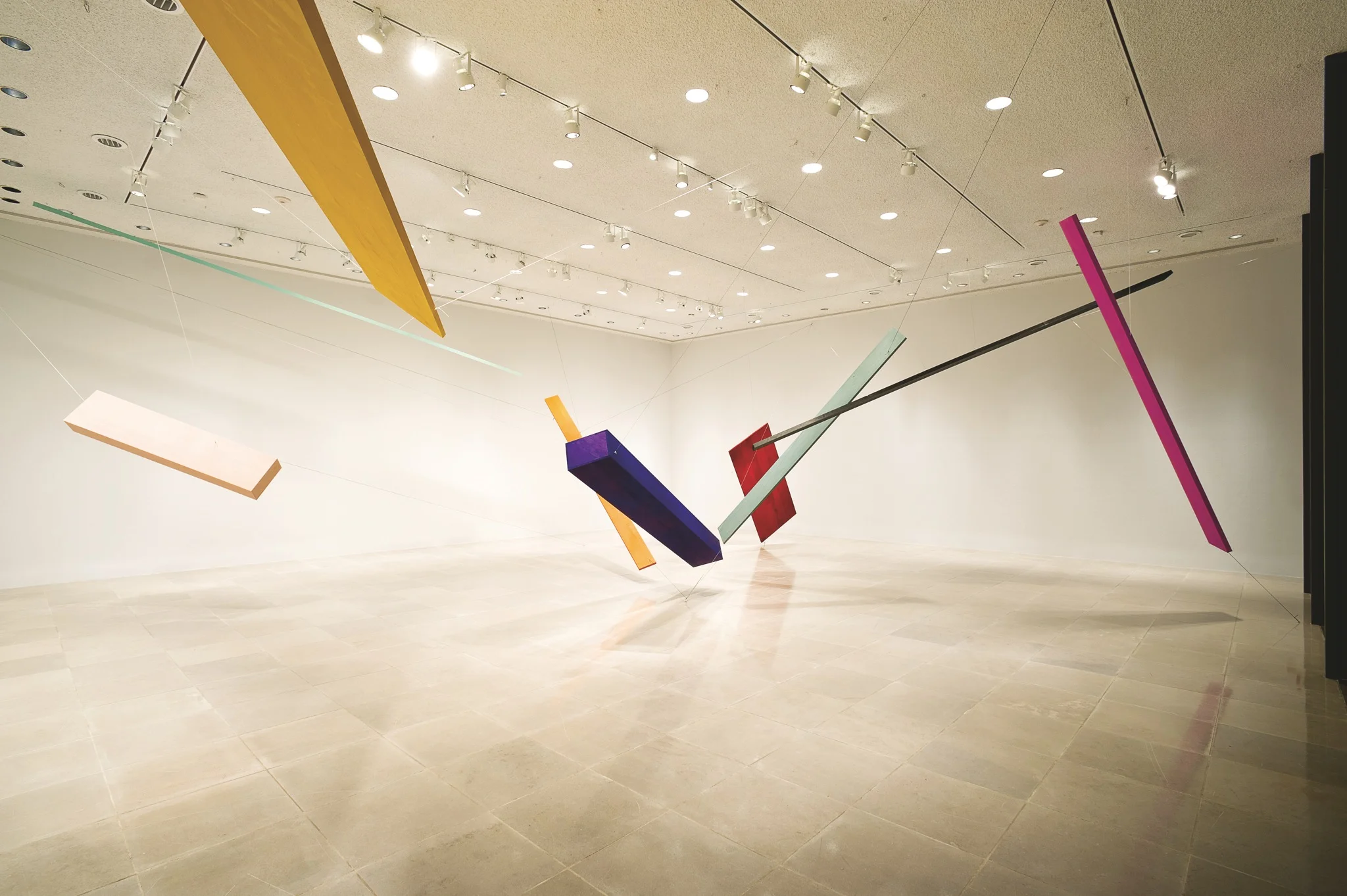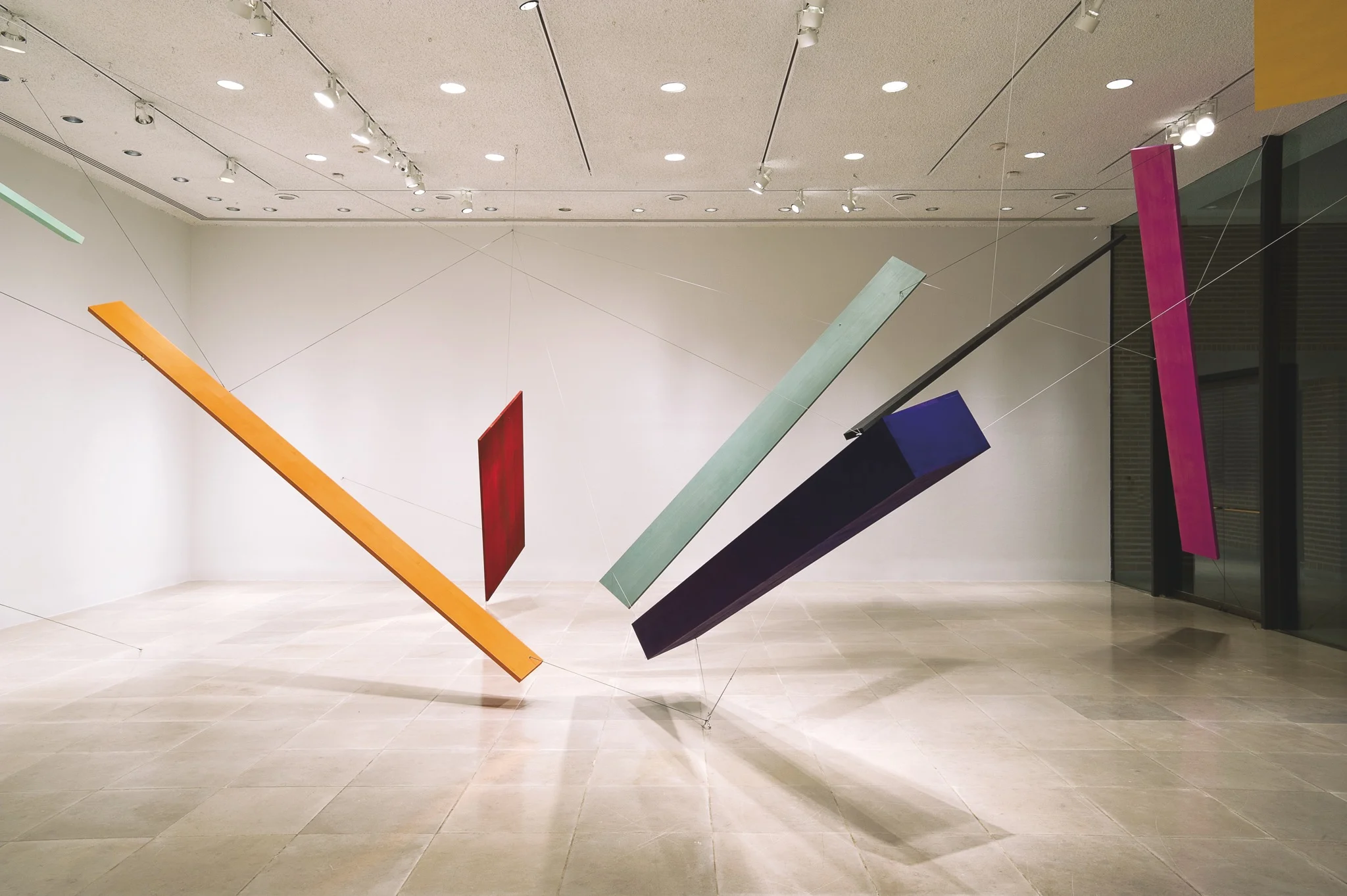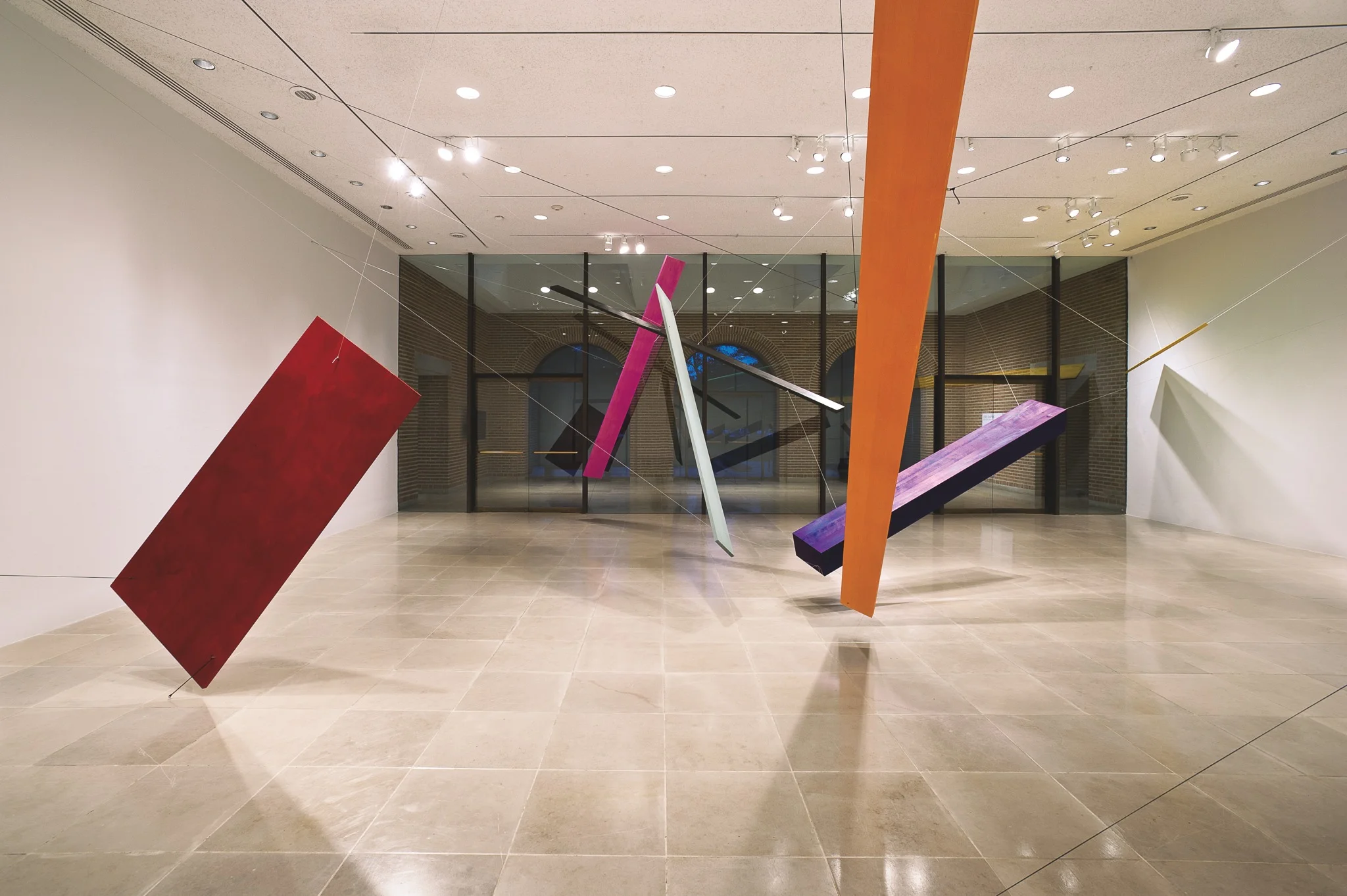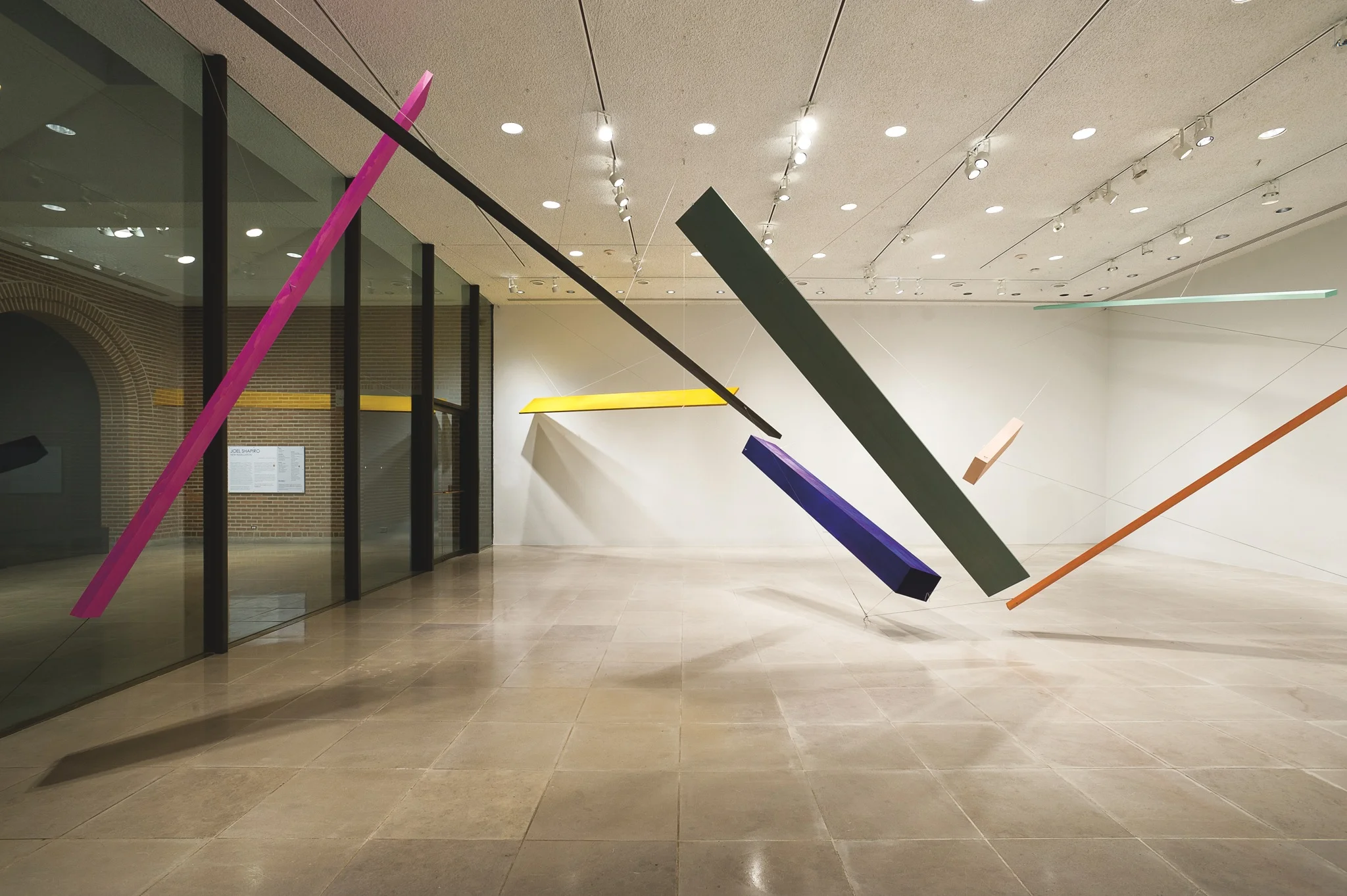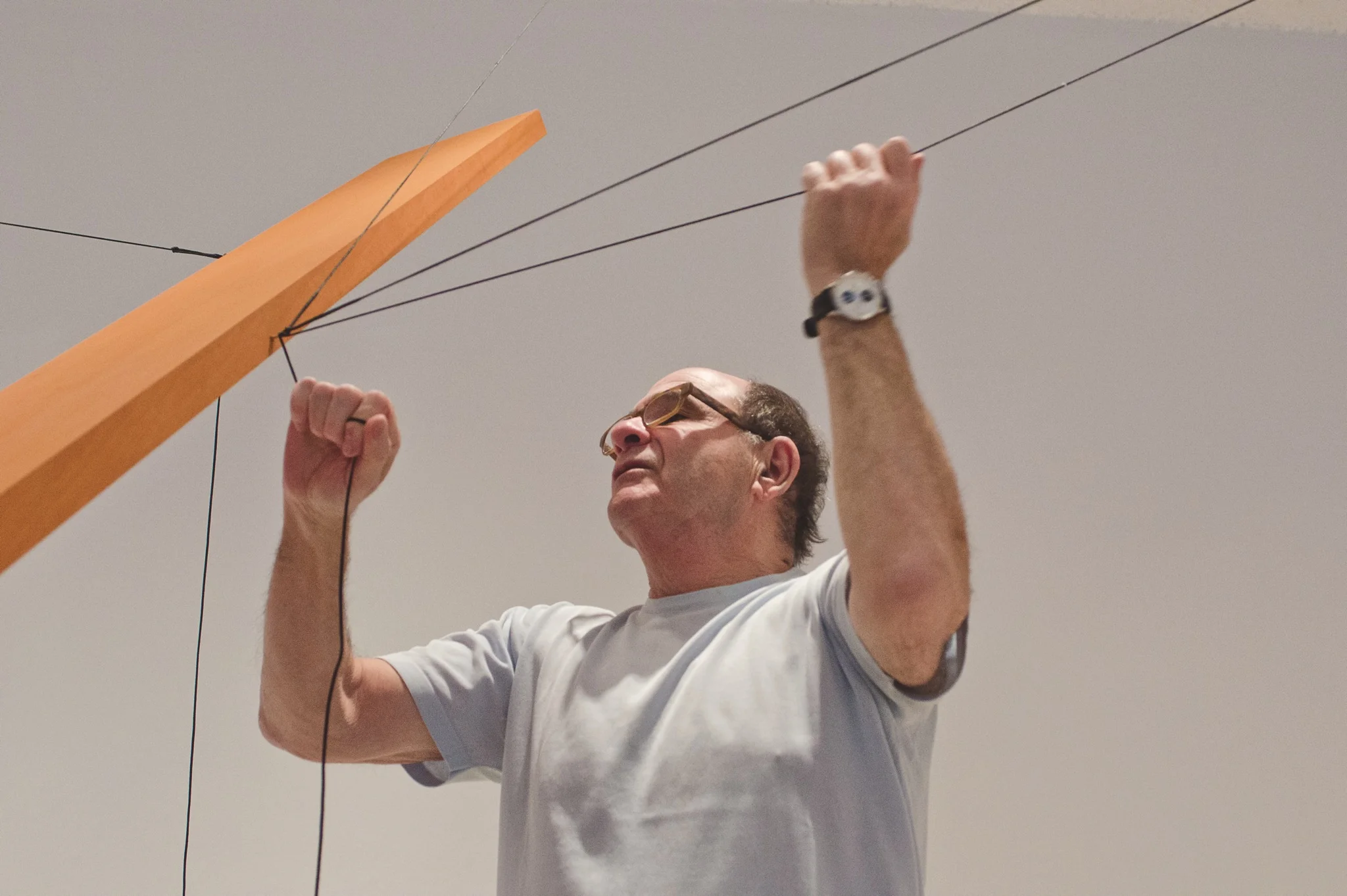Joel Shapiro Untitled
2 FEBRUARY - 18 MARCH 2012
Joel Shapiro’s new installation at Rice Gallery is a gravity-defying array of color, form, shape, and line. Wooden elements, vibrantly painted with supersaturated pigment and casein, seemingly levitate in the air as they are held in tension by string stretching from the center of the gallery’s floor to points on the ceiling. The individual elements are physically tied to the surrounding architecture, yet seem completely free from it as they float and twist in a state of suspended animation. The configuration is at once formally rigorous and utterly spontaneous, as color and form appear to simultaneously implode and explode from the center of the gallery space.
A celebrated artist who has been making work since the late 1960s, Joel Shapiro is well known for his geometric, abstract sculptures that appear to bound across museum walls, floors, and sculpture gardens. In these sculptures that often allude to the human figure, Shapiro recombines simple forms to play with the internal and external relationships that define a sculpture. He looks at how the individual parts relate to one another, and how the sculpture as a whole relates to its surroundings (floor, ceiling, and viewer). Using dynamic ways of joining wood, bronze, or metal, Shapiro creates work with a vitality and energy that is completely new and fresh, and at the same time, addresses fundamental formal concerns that cross centuries of art making.
Shapiro notes that one of the basic questions that has driven him as a sculptor is, “How do you animate material so inanimate, so obdurate?” For an exhibition in 2005 at the Musée dOrsay in Paris, France, Shapiro choose to enlarge an existing small-scale sculpture because of what he saw as a remarkable correspondence it had to the formal elements of Jean-Baptiste Carpeaux’s Dance (1865-1869). His resulting work, 20 Elements, was a tumbling, riotous arrangement of rectangular shapes in bold primary colors. It echoed, and yet departed from Carpeaux’s work, as they both engaged in the same struggle to create movement out of inert material, in Shapiro’s case, wood, and Carpeaux’s, stone.
Since 2002, Shapiro has dealt with the idea of form collapsing, free from structure. In a series of sculptures, he uses string or wire to suspend seemingly loose arrangements of painted and unpainted wood. He has slowly refined and pulled apart these wooden clusters to move into his current approach to installation, which he describes as “the projection of thought into space without the constraint of architecture.” He adds, “I feel like I’ve been working for so long to have finally built up this moment of discovery that I can get the work off the floor and be more playful in the air.”
Deceptively simple, Shapiro’s Rice Gallery installation is the accumulation of a lifetime of experience as a sculptor. Formal decisions are made intuitively: the size, shape, and thickness of the individual planks of spruce wood; the color and density of paint; the relative angle and distance apart to suspend each form in relation to one another and the gallery space, and finally the number of strings and required tension to hold them in place. As Shapiro explains, “There are some boundaries — gravity and the space and whatever materials you choose to use — but beyond that there’s a certain degree of freedom.”
To work out these complex relationships, Shapiro made a scale model of Rice Gallery to become familiar with the space. He worked within this model and then on an actual scale mock-up in New York studio. As he worked back and forth between the model and the mock-up, he sensed the beginning of an installation seemingly about the dispersal of a human figure, “not ripped apart, but animate, expanding.” As he altered it, the mock-up kept “sinking down in the studio, getting lower and lower, and looked better and better because it had a greater sense of gravity.” He slowly added pieces, fabricated the final wooden parts, and adapted the model to use as a guide to work from at Rice Gallery. Over the course of a week as he worked on site, Shapiro did not rigidly follow the model, but assessed the work in the gallery space to find a final composition.
In the final installation, the elements are loosely organized around a weighty, diagonal block of deep blue. It is the first time Shapiro has suspended a volumetric form in one of his installations, as opposed to using only the flat boards. Shapiro explains, “I wanted it to levitate. I wanted it lower to the ground, so you had a sense of its gravity. That was the principal organizing element, and then dispersed from that point on.” This beam is painted “Paris Blue,” a pigment mixed with casein that shifts from a deep blue to purple as it absorbs light differently. Shapiro describes his use of color as “naturalistic.” As he attempted to find the right synthesis of color and shape, he tried to avoid using color that looked too “canned” or decorative. A skinny line is painted “Lamp Black,” a large rectangle an “Urbino Red,” and a long plank a “Cobalt Violet,” to name a few.
As visitors move through the installation, the geometric shape and color of each individual element changes, as well as how the different parts relate. Shapiro notes, “In a piece like this, as you walk through it, it reconfigures, which is some essential aspect of sculpture. It [sculpture] is very different from a painting. It unfolds in time and space.”
Just as the individual elements could be endlessly rearranged by Shapiro, the experience of the installation itself seems as if it could be infinitely varied. Says Shapiro:
There is no perfect arrangement. That’s part of the game. You can be creative and invent something. You could take those elements, reconfigure them, and perhaps be more exciting or less exciting. It’s just a moment in time.
ABOUT THE ARTIST
Joel Shapiro was born in 1941 in New York, where he still lives. Active as an artist since the late 1960s, his work is represented in the permanent collections of major museums throughout the world, including The Museum of Fine Arts, Houston and The Menil Collection, Houston. Solo exhibitions include the Museum of Contemporary Art, Chicago (1976); Whitney Museum of American Art, New York (1982-83); Hirshhorn Museum and Sculpture Garden, Washington, DC (1987-88); Louisiana Museum for Moderne Kunst, Humlebæk, Denmark (1990); The Metropolitan Museum of Art, New York (2001); Musée d’Orsay, Paris (2005), and Museum Ludwig, Cologne, Germany (2010). In 2011, Shapiro oversaw the installation of For Jennifer, a monumental, painted aluminum sculpture commissioned by theDenver Art Museum, and sited near the newly opened Clyfford Still Museum in
Denver, Colorado.
PRESS
Post on
Minimalissimo
28 May 2012
Post on
MoCo Loco
16 February 2012
Article by Meredith Deliso,
Houston Press
15 February 2012
Post on
+MOOD
12 February 2012
Post by Jose Villarreal,
Artdaily.org
9 February 2012
Article by Tyler Rudick,
CultureMap
2 February 2012
Post by Katy Crocker,
AdobeAirstream
2 February 2012
PAST PRESS
Article by Jose Villarreal,
Artdaily.org
26 February 2011
Post by Brian Fee,
Fee’s List
20 April 2010
Interview with Michèle Gerber Klein,
BOMB Magazine
Fall 2009
Interview with Phong Bui,
The Brooklyn Rail
November 2007
Photos by Nash Baker © nashbaker.com


